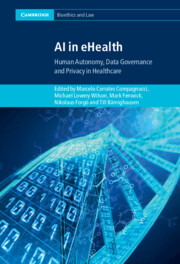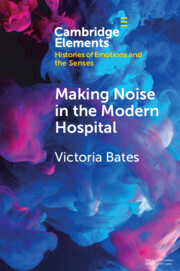225 results
Food providers and public health professional’s experiences with the adoption and implementation of the National Healthy Food and Drink Policy in New Zealand healthcare facilities
-
- Journal:
- Proceedings of the Nutrition Society / Volume 83 / Issue OCE1 / April 2024
- Published online by Cambridge University Press:
- 07 May 2024, E61
-
- Article
-
- You have access
- Export citation
A Discipline Like No Other: Marginalized Autonomy and Institutional Anchors in French Public Psychiatry (1945–2016)
-
- Journal:
- Comparative Studies in Society and History , First View
- Published online by Cambridge University Press:
- 27 March 2024, pp. 1-30
-
- Article
-
- You have access
- Open access
- HTML
- Export citation
Perspectives on Communication Technology Use for Alleviating the Impact of COVID-19 on Hospitalized Patients’ Well-Being and Transitions in Care
-
- Journal:
- Canadian Journal on Aging / La Revue canadienne du vieillissement , First View
- Published online by Cambridge University Press:
- 19 February 2024, pp. 1-8
-
- Article
-
- You have access
- Open access
- HTML
- Export citation
11 - Exempt Income and Non-Assessable Non-Exempt Income
- from Part D - Income
-
- Book:
- Foundations of Taxation Law
- Published online:
- 09 February 2024
- Print publication:
- 15 February 2024, pp 281-292
-
- Chapter
- Export citation
9 - Hospitals
- from Part II - Providers
-
- Book:
- Economics of Healthcare
- Published online:
- 02 November 2023
- Print publication:
- 23 November 2023, pp 113-126
-
- Chapter
- Export citation
5 - Infrastructures of Extraction, Sanitation, and Care
-
- Book:
- When Disease Came to This Country
- Published online:
- 20 July 2023
- Print publication:
- 10 August 2023, pp 119-153
-
- Chapter
- Export citation
Disaster Preparedness and Hospital Safety in State Hospitals in Lima (Peru)
-
- Journal:
- Prehospital and Disaster Medicine / Volume 38 / Issue 5 / October 2023
- Published online by Cambridge University Press:
- 10 August 2023, pp. 601-605
- Print publication:
- October 2023
-
- Article
-
- You have access
- Open access
- HTML
- Export citation
9 - A Smouldering Fire
-
- Book:
- When Disease Came to This Country
- Published online:
- 20 July 2023
- Print publication:
- 10 August 2023, pp 257-292
-
- Chapter
- Export citation
Assessing enrollment of eligible infants in the national pediatric cardiology quality improvement collaborative (NPC-QIC) through linkage to the pediatric cardiac critical care consortium (PC4) registry
-
- Journal:
- Cardiology in the Young / Volume 34 / Issue 2 / February 2024
- Published online by Cambridge University Press:
- 12 July 2023, pp. 373-379
-
- Article
- Export citation
Monitoring Mental Health: Legal and Ethical Considerations of Using Artificial Intelligence in Psychiatric Wards
-
- Journal:
- American Journal of Law & Medicine / Volume 49 / Issue 2-3 / July 2023
- Published online by Cambridge University Press:
- 12 February 2024, pp. 250-266
- Print publication:
- July 2023
-
- Article
-
- You have access
- Open access
- HTML
- Export citation
Disease control and the disposal of infectious materials in Renaissance Rome: excavations in the area of Caesar's Forum
-
- Article
-
- You have access
- Open access
- HTML
- Export citation
Factors Influencing Hospitals’ Disaster Preparedness in the Eastern Province of Saudi Arabia
-
- Journal:
- Disaster Medicine and Public Health Preparedness / Volume 17 / 2023
- Published online by Cambridge University Press:
- 14 February 2023, e301
-
- Article
-
- You have access
- Open access
- HTML
- Export citation
Chapter 27 - Harnessing the Contribution of the Private Health Care Sector toward Public Health Goals
- from Section 2 - Transforming Health Systems: Confronting Challenges, Seizing Opportunities
-
-
- Book:
- Making Health Systems Work in Low and Middle Income Countries
- Published online:
- 08 December 2022
- Print publication:
- 29 December 2022, pp 421-434
-
- Chapter
- Export citation
Hospitals Disaster Preparedness and Management in the Eastern Province of the Kingdom of Saudi Arabia: A Cross-sectional Study – CORRIGENDUM
-
- Journal:
- Disaster Medicine and Public Health Preparedness / Volume 17 / 2023
- Published online by Cambridge University Press:
- 12 December 2022, e261
-
- Article
-
- You have access
- HTML
- Export citation
1 - Mapping the Digital Healthcare Revolution
-
-
- Book:
- AI in eHealth
- Published online:
- 08 September 2022
- Print publication:
- 15 September 2022, pp 1-16
-
- Chapter
- Export citation

AI in eHealth
- Human Autonomy, Data Governance and Privacy in Healthcare
-
- Published online:
- 08 September 2022
- Print publication:
- 15 September 2022
Disestablishing Hospitals
-
- Journal:
- Journal of Law, Medicine & Ethics / Volume 49 / Issue 4 / Winter 2021
- Published online by Cambridge University Press:
- 10 January 2022, pp. 542-551
- Print publication:
- Winter 2021
-
- Article
-
- You have access
- Open access
- HTML
- Export citation

Making Noise in the Modern Hospital
-
- Published online:
- 12 November 2021
- Print publication:
- 09 December 2021
-
- Element
- Export citation
Breaking the silence: Advocacy and accountability for attacks on hospitals in armed conflict
-
- Journal:
- International Review of the Red Cross / Volume 102 / Issue 915 / December 2020
- Published online by Cambridge University Press:
- 04 November 2021, pp. 1201-1226
-
- Article
-
- You have access
- Open access
- HTML
- Export citation
6 - Hospitals, Doctors and Nurses
-
- Book:
- Comparative Health Systems
- Published online:
- 20 August 2021
- Print publication:
- 09 September 2021, pp 145-178
-
- Chapter
- Export citation



